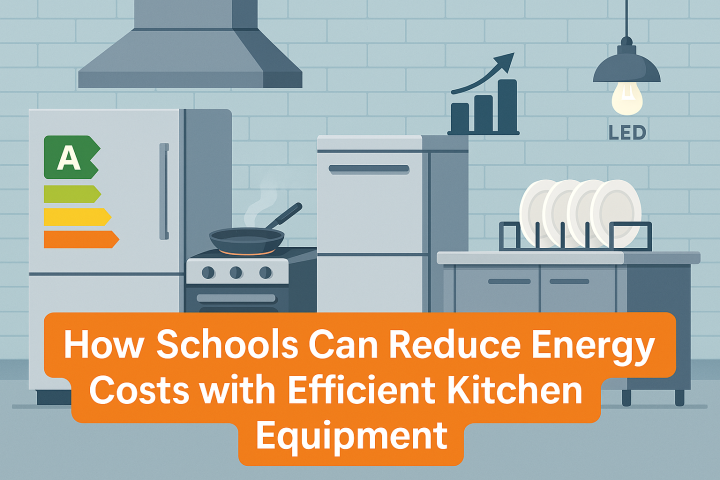Schools operate on tight budgets, and with energy costs continuing to rise, finding ways to save on electricity and gas bills is essential. One often-overlooked area where schools can make significant savings is in their commercial kitchens. By investing in energy-efficient kitchen equipment and following best practices, schools can reduce energy waste, lower costs, and contribute to a more sustainable environment.
Energy efficiency in school kitchens is not just about cutting costs; it also promotes sustainability and environmental responsibility. Schools have a duty to set an example for students by adopting greener practices that reduce their carbon footprint. Additionally, improved energy efficiency can enhance kitchen performance, ensuring that food preparation is faster and more effective while maintaining high safety standards.

The Importance of Energy Efficiency in School Kitchens
School kitchens consume a substantial amount of energy due to their reliance on ovens, refrigerators, dishwashers, and ventilation systems. Inefficient equipment can lead to excessive energy consumption, increasing operational costs. Upgrading to energy-efficient appliances can result in significant long-term savings.
Beyond direct energy savings, maintaining an efficient school kitchen also contributes to equipment longevity. When appliances are overworked or running inefficiently, they are more likely to break down, leading to costly repairs or replacements. By optimising energy efficiency, schools can maximise the lifespan of their kitchen equipment, reducing overall expenses.
Ways to Reduce Energy Costs in School Kitchens
- Upgrade to Energy-Efficient Equipment
Modern kitchen appliances come with energy-efficient features such as better insulation, faster cooking times, and reduced standby energy consumption. Look for Energy Star-rated or eco-friendly equipment, which typically consumes 20-30% less energy than traditional appliances.
For example:
- Induction Cooktops – More efficient than gas stoves, heating up instantly and reducing wasted energy.
- Combi Ovens – Multi-functional and designed to use precise amounts of energy for cooking, steaming, and baking.
- Energy-Efficient Refrigerators and Freezers – Utilise improved insulation and smart sensors to optimize cooling cycles.
Investing in these appliances may have a higher upfront cost, but the savings in energy bills over time make them a worthwhile investment.
- Regular Maintenance and Servicing
Well-maintained equipment runs more efficiently. Scheduled servicing ensures that appliances function optimally, reducing unnecessary energy usage. Simple maintenance tasks, such as cleaning refrigerator coils, descaling dishwashers, and checking gas burners for efficiency, can significantly impact energy consumption.
By implementing a preventative maintenance plan, schools can:
- Avoid costly emergency repairs
- Ensure appliances are running at peak performance
- Reduce the likelihood of unexpected breakdowns
- Use Smart Kitchen Practices
Training kitchen staff on best energy-saving practices can further reduce costs. Some simple yet effective methods include:
- Turning Off Unused Appliances – Equipment left on standby still consumes electricity. Ensure that ovens, fryers, and warming units are turned off when not in use.
- Batch Cooking – Cooking in bulk reduces the number of times ovens and stoves need to be heated.
- Efficient Dishwasher Use – Only running dishwashers when they are full minimises water and electricity waste.
- Proper Refrigerator Loading – Overloading or underloading can reduce efficiency, making cooling cycles work harder than necessary.
By creating an energy-conscious culture in school kitchens, staff can contribute significantly to overall cost savings.
- Upgrade to LED Lighting
Lighting is often an overlooked source of energy consumption. Replacing traditional bulbs with LED lighting in kitchen areas can significantly cut down electricity costs. LED bulbs use at least 75% less energy and last 25 times longer than incandescent lighting, making them an easy and effective upgrade.
Consider installing task lighting in preparation areas to reduce the need for overhead lights when full kitchen lighting isn’t required.
- Install Energy-Saving Controls
Automated systems can help schools regulate energy use more efficiently:
- Motion Sensor Lighting – Ensures lights are only on when needed, reducing unnecessary energy waste.
- Programmable Thermostats – Adjusts heating and cooling in the kitchen during non-operational hours to conserve energy.
- Smart Energy Monitoring Systems – Provides real-time data on electricity usage, helping schools identify areas of improvement.
Some schools have seen up to a 15% reduction in energy costs by integrating smart energy controls into their kitchen management.
By investing in efficient kitchen equipment and adopting energy-conscious habits, schools can drastically reduce their energy costs, freeing up funds for other essential resources. Implementing simple changes, such as upgrading to energy-efficient appliances, performing regular maintenance, and utilising smart energy controls, can result in long-term savings and improved kitchen performance.
Beyond financial benefits, focusing on energy efficiency helps schools reduce their environmental impact, promoting sustainability and setting a positive example for students. Schools that take the initiative to optimise their kitchen energy use will not only see cost savings but will also contribute to a greener future.